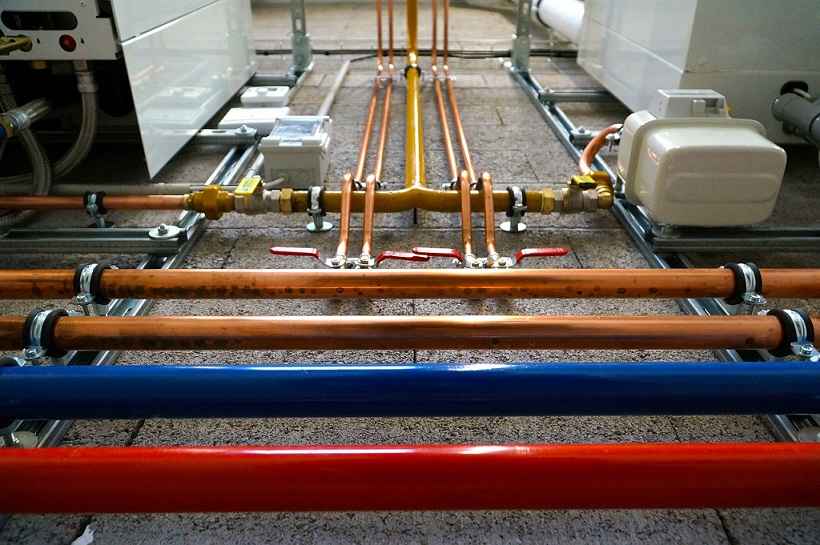
Top Strategies to Prevent Backflow in Your Plumbing System
Imagine this: you’re enjoying a nice, relaxing evening at home when suddenly, an unpleasant odor wafts through the air. You rush to investigate only to find that your plumbing system has betrayed you—backflow has turned your sanctuary into a nightmare! Backflow is not just an inconvenience; it’s a health hazard that can disrupt your life and damage your property. But fear not! In this post, we’ll dive deep into essential strategies for preventing backflow in your plumbing system. From simple DIY measures to professional solutions, we’ve got the tips you need to keep your water clean and flowing smoothly. Say goodbye to unexpected messes and hello to peace of mind as we guide you through effective ways to safeguard your home against unwanted backflows! Let’s get started on securing the heart of your household—your plumbing system!
Introduction to Prevent Backflow and Its Dangers
Backflow in your plumbing system might sound like a minor inconvenience, but it can lead to serious health risks and costly repairs. Imagine contaminated water flowing back into your clean supply—it’s a scenario no one wants to face. Understanding what causes backflow and how to prevent it is essential for every homeowner or business owner. With the right strategies in place, you can safeguard your property and ensure that clean water continues to flow freely. Let’s dive into the world of backflow prevention so you can keep your plumbing system safe and efficient!
Understanding the Causes of Backflow
Backflow occurs when water flows in the opposite direction, often leading to contamination of clean water supplies. Understanding its causes is crucial for effective prevention.
One primary culprit is cross-connections. These happen when a link forms between potable and non-potable water sources. For example, a garden hose submerged in soapy water can create a pathway for contaminants to enter your drinking supply.
Another factor is pressure changes within the plumbing system. If there’s a sudden drop in pressure—perhaps due to heavy usage or pipe ruptures—water can be drawn backward from contaminated areas into clean lines.
Gravity also plays a role, particularly in systems with elevation changes. When waste flows downhill but faces an obstruction, it may reverse direction instead of continuing on its intended path.
Identifying these triggers helps homeowners and businesses take proactive measures against backflow risks.
-
Cross-connections and How They Lead to Backflow
Cross-connections exist when potable water lines intersect with non-potable sources. This creates a potential pathway for contaminated water to flow back into the clean supply.
Imagine a hose submerged in a bucket of soapy water. If there’s a drop in pressure, that dirty water could easily siphon back through the hose and contaminate your drinking supply.
These connections can occur in various settings—homes, commercial buildings, or irrigation systems. Even simple tasks like washing your car can create risks if proper precautions aren’t taken.
Understanding where these cross-connections may be is critical for effective backflow prevention. Awareness helps you identify vulnerable areas before they become problematic. Regular checks on fixtures and outdoor spigots are key steps toward ensuring safe drinking water at all times.
-
Problems with Pressure and Gravity
Pressure and gravity play critical roles in a plumbing system. When these forces are disrupted, backflow can occur unexpectedly.
If the water pressure drops significantly—due to high demand or a leak—contaminated water may flow backward into clean lines. This is especially dangerous in systems that rely on consistent pressure to maintain hygienic conditions.
Gravity also impacts drainage systems. If wastewater cannot drain away properly, it can create siphoning effects. This means dirty water might be pulled back toward your potable supply instead of flowing out as intended.
Both scenarios highlight how fragile our plumbing networks can be under certain conditions. A slight imbalance might lead to significant health risks if not addressed promptly. Understanding these dynamics helps homeowners take proactive measures for effective backflow prevention.
Common Types of Backflow Prevention Devices
Backflow prevention is essential for maintaining safe drinking water. Various devices help achieve this goal, each designed for specific situations.
An air gap separation is one of the simplest and most effective methods. It involves creating a physical space between the water supply and potential contaminants, preventing any backflow from occurring.
Another popular choice is Reduced Pressure Zone (RPZ) assemblies. These devices contain two check valves separated by a pressure-regulated chamber. They are ideal for high-risk areas where contamination could pose serious health risks.
Double check valves offer an additional layer of protection. Comprising two independently acting check valves, these are perfect for non-health hazard applications but still require regular maintenance to ensure effectiveness.
Choosing the right device depends on your plumbing system’s unique needs and local regulations. Each option plays a critical role in safeguarding your water quality.
-
Air Gap Separation
Air gap separation is one of the simplest yet most effective methods for preventing backflow in plumbing systems. This technique involves creating a physical gap between the end of a water supply outlet and the level of any potentially contaminated liquid.
The space allows gravity to play its role, ensuring that even if there’s a drop in pressure, contaminated water cannot flow back into the clean water supply. It’s commonly seen at sink faucets or dishwashers.
Installing an air gap is straightforward and requires minimal maintenance. Regularly checking this area helps ensure it’s free from obstructions like debris or buildup.
This method not only protects your drinking water but also serves as a visual reminder to homeowners about maintaining safe plumbing practices. A clear air gap indicates a commitment to hygiene and safety within your home.
-
Reduced Pressure Zone (RPZ) Assemblies
Reduced Pressure Zone (RPZ) assemblies are crucial components in backflow prevention. They work by creating a physical barrier against potential contamination from the water supply.
An RPZ assembly contains two check valves and a pressure differential relief valve. This setup helps maintain safe drinking water by ensuring that, under any circumstance, contaminants cannot flow back into the main system.
When water pressure drops unexpectedly, the relief valve opens to release excess pressure. This action protects your plumbing from harmful substances infiltrating through cross-connections.
Regular maintenance is essential for RPZ assemblies to function effectively. Inspections should focus on checking for leaks and ensuring all parts are functioning properly.
Installing an RPZ assembly not only enhances safety but also complies with local regulations regarding backflow prevention measures. It’s a smart investment for both residential and commercial properties looking to safeguard their water quality.
-
Double Check Valves
Double check valves are essential components in backflow prevention systems. They consist of two independently acting check valves housed within a single assembly. This design ensures that if one valve fails, the other can still provide protection against contaminated water entering clean supply lines.
These valves work by allowing water to flow in one direction while preventing reverse flow. Their simplicity makes them an attractive option for many residential and commercial applications.
Installation is straightforward, but proper placement is crucial for optimal performance. Positioning should be at least 12 inches above the highest downstream outlet to effectively mitigate any potential backflow risks.
Routine maintenance is necessary to keep double check valves functioning properly. Regular inspections help identify wear and tear or obstructions that could compromise their effectiveness over time, ensuring safe water systems remain intact without interruption.
Tips for Maintaining Your Backflow Prevention System
Regular inspections are vital to ensure your backflow prevention system is functioning correctly. Schedule these checks at least once a year, or more frequently if you notice any issues.
Proper installation and timely replacement of components also play a key role. If you’re uncertain about the status of your devices, consult a professional plumber for advice.
Flushing out the system periodically can help clear debris that builds up over time. This simple maintenance step keeps everything flowing smoothly and reduces the risk of contamination.
Don’t forget to document all maintenance activities. Keeping records allows you to track service history and helps identify potential problems early on.
A proactive approach will protect both your plumbing infrastructure and public health by ensuring efficient backflow prevention measures are always in place.
-
Regular Inspections
Regular inspections are crucial for effective backflow prevention. Scheduling these checks can save you from potential health hazards and costly repairs.
During an inspection, a professional will evaluate your plumbing setup. They’ll look for any signs of wear or damage that could compromise the system’s integrity. Early detection helps to address issues before they escalate.
It’s also important to verify that all backflow prevention devices are functioning correctly. Devices like RPZ assemblies should meet local regulations and standards.
Consider setting up a routine maintenance plan with a licensed plumber. This ensures your system remains compliant and efficient year-round. Regularly documenting these inspections contributes to accountability as well.
Don’t underestimate the importance of this proactive approach in safeguarding your water quality and protecting your property from contamination risks. Prioritize regular inspections to keep everything flowing smoothly!
-
Proper Installation and Replacement
Proper installation and replacement of backflow prevention devices are crucial for their effectiveness. When installing a new device, ensure it’s done by a certified professional who understands local codes and regulations. A skilled technician can identify the right type of device needed based on your system’s design and requirements.
During replacement, pay attention to the condition of existing equipment. Old or worn-out parts may not provide adequate protection against backflow. Inspecting connections and seals is vital to prevent leaks.
Always follow manufacturer guidelines during installation. Each model has specific instructions that enhance performance and longevity. This careful approach helps maintain water quality throughout your plumbing system.
Regularly reviewing installed systems also plays an essential role in preventing issues before they arise. Keeping track of when replacements are due will help you stay ahead of potential problems down the line.
-
Flushing Out the System
Flushing out your plumbing system is a crucial step in backflow prevention. It helps clear any sediment, debris, or contaminants that may build up over time.
Regular flushing keeps your pipes clean and reduces the risk of backflow incidents. The process ensures that water flows freely through the system. This not only enhances efficiency but also prolongs the lifespan of your plumbing infrastructure.
Make sure to follow local guidelines when performing this task. Different systems may have specific requirements for effective flushing.
Consider scheduling flushes during seasonal changes or after heavy rainfalls, as these events can introduce additional contaminants into the system. Always monitor for unusual smells or discolored water afterward; these could be signs that more extensive maintenance is needed.
Investing time in this simple practice can save you from costly repairs and health hazards down the line.
Best Practices for Preventing Backflow in Your Home or Business
To effectively prevent backflow in your home or business, start by properly disposing of chemicals and waste. Never pour hazardous materials down the drain. Instead, utilize designated disposal methods to keep contaminants out of your plumbing system.
Managing outdoor water sources is equally crucial. Ensure that sprinklers and hoses are not submerged in ponds or pools where contamination could occur. Use hose bib vacuum breakers to protect against potential backflow from garden watering.
Educating yourself and those around you can make a significant difference. Share knowledge about the importance of backflow prevention with family members or staff. Awareness can lead to proactive measures being taken whenever plumbing issues arise.
Regularly review your practices and equipment as well. Keeping an eye on existing systems ensures they remain functional and effective at preventing any unwanted flow into clean water supplies.
-
Properly Disposing of Chemicals and Waste
Proper disposal of chemicals and waste is essential for backflow prevention. Many household cleaners, paints, and pesticides contain harmful substances that can contaminate your water supply if not discarded correctly.
Always read labels before disposing of any chemical product. Some may have specific instructions for safe disposal. Follow these guidelines to minimize risks.
Never pour hazardous materials down the drain or toilet. This practice can create cross-connections in your plumbing system, leading to unwanted backflow issues.
Instead, utilize local hazardous waste collection programs or drop-off centers designed for such items. These facilities ensure proper handling and prevent potential contamination.
Educating yourself about eco-friendly alternatives also helps reduce chemical usage at home. Opting for biodegradable products keeps both your plumbing and environment safer while maintaining effective cleaning practices.
-
Managing Outdoor Water Sources
Managing outdoor water sources is crucial for effective backflow prevention. Always check your irrigation systems, hoses, and spigots to ensure they’re functioning properly.
Avoid creating cross-connections by using hose bibs with backflow preventers. These devices stop contaminated water from entering your clean supply.
If you have a pool or fountain, be mindful of their drainage systems. Ensure they are set up correctly to minimize the risk of contamination during heavy rain or when draining.
Regularly inspect any outdoor plumbing fixtures for leaks or damages. Even small issues can lead to significant problems if left unchecked.
Lastly, educate everyone in your household about the importance of proper outdoor water management practices. Simple awareness can go a long way in maintaining safe drinking water standards at home.
-
Educating Yourself and Your Family/Staff
Understanding backflow prevention is essential for safeguarding your health and property. Education plays a crucial role in this process. By informing yourself, your family, or staff about the risks associated with backflow, you empower everyone to take action.
Start by sharing knowledge about what backflow is and how it can impact water quality and safety. Discuss proper practices for using sinks, toilets, and outdoor hoses, emphasizing the importance of avoiding cross-connections. Make sure everyone knows where the main shut-off valve is located in case of an emergency.
Consider organizing training sessions or workshops focused on plumbing safety. These gatherings can be a great way to encourage questions and foster discussions around best practices for maintaining plumbing systems.
Regularly update everyone on any changes to local regulations regarding water use or chemical disposal. Keeping abreast of these updates ensures that all parties are compliant with current laws while also reinforcing safe habits related to plumbing maintenance.
By promoting an environment of learning and active participation in backflow prevention efforts at home or work, you not only enhance safety but also build community awareness around this often-overlooked issue. Taking these proactive steps will help ensure clean drinking water remains accessible for all.


